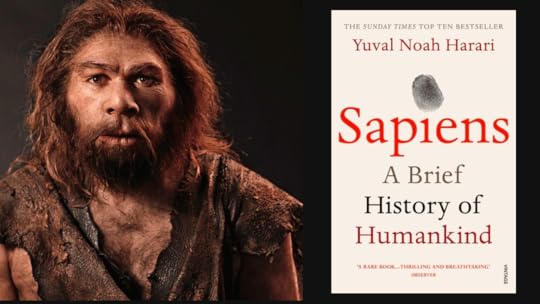Sapiens Chapter 2 Summary – The Tree of Knowledge
The second chapter of Sapiens by Yuval Noah Harari continues the story of Homo sapiens.
In the first chapter (An Animal of No Significance), we learnt that the rise of Homo sapiens led to the eventual extinction of all other human species. However, it was far from a smooth transfer of power.
.stk-57162c2{margin-bottom:0px !important}.stk-57162c2-container{box-shadow:0 5px 30px -10px rgba(18,63,82,0.3) !important} .stk-9cbdf58{margin-bottom:0px !important}Sapiens Chapter 1 Summary – An Animal of No Significance
.stk-9cbdf58{margin-bottom:0px !important}Sapiens Chapter 1 Summary – An Animal of No SignificanceAnimals resembling a lot like modern humans started walking the Earth some 2.5 million years ago. However, an early human was an animal of no significance in the grand scheme of things.
In fact, the first recorded encounter between the Sapiens and Neanderthals ended with Neanderthal victory. This happened a 100,000 years ago when Sapiens groups first attempted to migrate to the North of Levante into Neanderthal territory. However, they failed to secure a firm footing in the region, probably due to a combination of factors. Eventually, they retreated back to their territory.
Nevertheless, the Sapiens returned. Beginning around 70,000 years ago, Sapiens bands left Africa once again. This time they were so successful that they ended up wiping out the Neanderthals and all other human species from the face of the Earth.
Their movement was swift. In a short period of time, Sapiens had reached Europe and East Asia. About 45,000 years ago, they even crossed the open sea and reached Australia. This period saw the invention of boats, lamps, bows and arrows. The first definitive signs of art such as the Stadel lion-man emerged during this period along with clear evidence for religion, commerce and social stratification.
What was the change that caused this remarkable shift in the progress of Sapiens?
What transformed an obscure human species into the masters of the planet?
In this chapter, Harari tries to answer these questions.
The Cognitive RevolutionBased on the poor achievements of the first group of Sapiens, the scholars have concluded that the internal structure of the Sapiens brain was much different from ours. Though they looked like us, their cognitive abilities (learning, remembering, and communicating) were quite limited.
However, the people who drove the Neanderthals to extinction, reached far-flung places like Australia and carved intricate pieces of art were as intelligent, creative and sensitive as us. The unprecedented achievements of the second group of Sapiens were a product of a revolution in their cognitive abilities.
Sometime between 70,000 to 30,000 years ago, a Cognitive Revolution took place.
It is hard to pin down the exact reason for this revolution. The dominant theory suggests that accidental genetic mutations changed the inner wiring of the brain of Sapiens. This allowed them to think in unprecedented ways and communicate using a new form of language. We can also call it the Tree of Knowledge.
Why Language Matters?Communication is not special as such. Every animal on this planet communicates in some form.
In fact, many animals including apes and monkeys even use vocal signs. For example, green monkeys have different warning call signs for eagles or lions. Though Sapiens can produce more complex sounds, whales and elephants have equally impressive abilities.
So what is so special about our language?
There are two main theories.
First, our language is supple . We can combine a limited number of sounds to produce an infinite number of sentences with distinct meanings. Instead of a simplistic call sign for a lion, we can describe the exact location of the lion.Second theory is known as the gossip theory. We are social animals and cooperation is the key to our survival and reproduction. More than the location of lions or bisons, it is important for humans to know about each other. Even in a band of 50 members, there is a staggering amount of interpersonal information to store and track. Our language allowed us to build bigger bands by leveraging the power of gossip.In my opinion, the gossip theory is a very interesting way to look at things. Even in a small group of people, there is a web of interconnected relationships between individuals. Gossip keeps floating around from one individual to the other. While it can be frowned upon, gossip results into information that tells us whom to trust and whom to avoid.
Harari specifies that both the theories may be correct. But there is another unique feature of our language that is far more important. It is the ability of humans to transmit information about things that do not exist at all. Sapiens is the only species that can talk about entities that they have never seen, touched or smelled.
In Harari’s view, this unique feature of our language led to the emergence of legends, myths, gods and religions. The invention of fiction gave rise to collective imagination, allowing Sapiens to co-operate effectively in large numbers even with strangers.
While other animals such as ants and bees also work together, they do so in a very rigid manner and only with close relatives. Wolves and chimpanzees can also co-operate effectively, but only with a small number of individuals they know intimately.
 Ants working together
Ants working togetherHowever, Sapiens are different. Two complete strangers following the Catholic religion can fight for each other simply on the basis of following the same ideology. Two citizens of America, who don’t know each other, can work together to defend the country, because they believe in the country called America. Sapiens can collaborate in larger and larger groups by cultivating a sense of common myth or identity.
According to Harari, there is not much difference between a primitive tribe cementing their social order by believing in spirits and a multinational organization with thousands of employees working together for profits. Spirits and multinational organizations are both a figment of our imagination. Both are part of the fiction we have invented.
This may be one of the most polarizing points about this chapter. Harari labels gods and religions as nothing more than legends and myths. Of course, a lot of people may vehemently disagree with this notion. But that is the whole point. Since a lot of us believe so strongly in religion, it is such a powerful force to unite people towards a common goal. The same is the case for companies. A company is nothing but legal fiction conjured by a team of lawyers. It holds authority because we believe in a set of laws that dictate the creation of a company.
In essence, Cognitive Revolution created a dual reality. On one side is the objective reality of rivers, trees and lions. Something you can touch and feel. Second is the imagined reality of nations, corporations and religions.
Breaking Free of the GenomeThis ability to create imagined realities out of language and words enabled a large number of strangers to co-operate with each other effectively. Also, it opened the door for rapid change.
By altering the myths people believe in, it is also possible to alter the way people co-operate. For example, during the French Revolution of 1789, the French population switched almost overnight from believing in the myth of the divine rights of kings to believing in the myth of sovereignty of the people.
Cognitive revolution opened a fast lane of cultural evolution, bypassing the traffic jams of genetic evolution.
Sapiens could change their behaviour rapidly in accordance with the changing needs. This was drastically different from other social animals where the behaviour is largely determined by their genes. Significant changes in social behaviour cannot occur without genetic mutations.
Ever since the Cognitive Revolution, Sapiens have been able to change their behaviour quickly. Also, transmission of new behaviour to future generations has happened without any need for genetic change. Sapiens have been able to transform their social structures, interpersonal relations, economic activities, governing styles in a matter of a decade or two.
Here, Harari gives the example of a hypothetical resident of Berlin born in the year 1900. Within a span of 100 years, the resident would have spent the childhood years in the Hohenzollern Empire. The adult years would have been in the Weimar Republic, the Nazi Third Reich and then, the Communist East Germany. However, the resident would have died as a citizen of a democratic and reunified Germany. At the end, the resident would have been a part of five different sociopolitical systems within a span of 100 years without any change to the person’s DNA.
This flexibility is the key to the success of Sapiens. In a one-to-one fistfight, Neanderthals would have probably beaten a Sapiens. But, in a conflict of hundreds, Neanderthals would not stand a chance.
Even if the Sapiens lost the first round, they could quickly invent new strategies to win the next time. While Neanderthals could communicate and share information about their enemies, they could not compose fiction. As a result, they had no way of co-operating effectively in large enough numbers.
Separation of Biology and HistoryIn my view, Cognitive Revolution is the underpinning of human evolution and success. Even cave-dwelling Sapiens used tools. The ancient spearhead was manufactured by a single person in a few minutes with the help of close friends. Yet, in a matter of 30,000 years, we have gone from spears to intercontinental ballistic missiles with nuclear warheads. This is because of the co-operation of millions of strangers (workers in uranium mines to the theoretical physicists in ivy league institutes) from all over the world. Without Cognitive Revolution, all of this would not have been possible.
Cognitive Revolution is the point when history became independent from biology.
The relation between biology and history framed the future of our species.
Biology sets the basic parameters for the behaviour and capacities of every species including the homo sapiens.The arena of biology, however, is extremely large. Within this arena, Sapiens can play an astounding variety of games. Each generation builds upon the knowledge of the previous generation creating a Tree of Knowledge.After the Cognitive Revolution, the behaviour of Sapiens could not be accurately determined based on biology alone. It was important to describe the historical evolution of their actions.But what happened after the Cognitive Revolution?
What games did our ancestors play in the arena of history?
Much of how our ancestors lived and evolved determines where we are today and how we feel about life.
All of these questions and more are discussed in the next chapter of the book.
.stk-fa3ae94{margin-bottom:0px !important}.stk-fa3ae94-container{box-shadow:0 5px 30px -10px rgba(18,63,82,0.3) !important} .stk-2ed806e{margin-bottom:0px !important}Sapiens Chapter 3 Summary – A Day in the Life of Adam and Eve
.stk-2ed806e{margin-bottom:0px !important}Sapiens Chapter 3 Summary – A Day in the Life of Adam and EveWho were our ancestors? What did they really feel? How did they live? The answer to these questions shape our identity even today. Find the truth…
The post Sapiens Chapter 2 Summary – The Tree of Knowledge first appeared on Saurabh Dashora.



